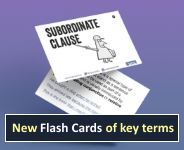Glossary: participle
Explanation
Verbs in English have two participles, called present participle (e.g. walking, taking) and past participle (e.g. walked, taken).
Unfortunately, these terms can be confusing to learners, because:
- they don’t necessarily have anything to do with present or past time
- although past participles are used as perfects (e.g. has eaten) they are also used as passives (e.g. was eaten).
- He is walking to school. [present participle in a progressive]
- He has taken the bus to school. [past participle in a perfect]
- The photo was taken in the rain. [past participle in a passive]
The present participle is sometimes called the -ing participle or gerund participle. The past participle is also called the -ed participle. A present participle clause (also called an -ing-clause) is a clause with a present participle as its Head verb. Example:
- Chewing on a sandwich, Pete tried to make a phone call at the same time.
A past participle clause (also called an -ed clause) is a clause with a past participle as its Head verb. Example:
- Kate flung herself onto the sofa, exhausted by a long day's work.
Englicious contains many resources for English language in schools, but the vast majority of them require you to register and log in first. For more information, see What is Englicious?

